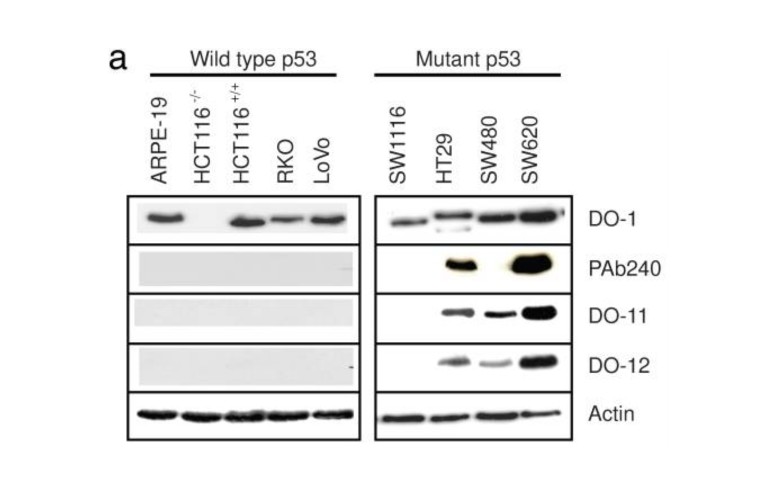Cat. #151147
Anti-p53 [Pab DO-1]
Cat. #: 151147
Sub-type: Primary antibody
Unit size: 100 ug
Availability: 1-2 weeks
Target: p53 (N terminus)
Class: Monoclonal
Application: ChIP ; IHC ; IF ; IP ; WB
Reactivity: Human
Host: Mouse
£300.00
This fee is applicable only for non-profit organisations. If you are a for-profit organisation or a researcher working on commercially-sponsored academic research, you will need to contact our licensing team for a commercial use license.
Contributor
Inventor: David Lane
Institute: University of Dundee
Primary Citation: Vojtesek et al. 1992. J Immunol Methods. 151(1-2):237-44. PMID: 1378473.
Tool Details
*FOR RESEARCH USE ONLY
- Name: Anti-p53 [Pab DO-1]
- Alternate name: P53, Trp53, pantropic
- Clone: Pab DO-1
- Tool sub type: Primary antibody
- Class: Monoclonal
- Conjugation: Unconjugated
- Molecular weight: 53 kDa
- Strain: Balb/c
- Reactivity: Human
- Host: Mouse
- Disease: Breast Cancer
- Application: ChIP ; IHC ; IF ; IP ; WB
- Description: A monoclonal p53 antibody, the epitope recognised is in the N terminus of p53. DO-1 recognises wild-type and mutant p53. DO-1 recognises three of the p53 isoforms (p53, p53β, p53γ).
- Immunogen: Recombinant human wild type p53 protein expressed in E.coli
- Immunogen uniprot id: P04637
- Isotype: IgG2a
- Myeloma used: Sp2/0-Ag14
- Recommended controls: MDA-MB-231 cell line
Target Details
- Target: p53 (N terminus)
- Molecular weight: 53 kDa
- Tissue cell line specificity: MDA-MB-231 cell line
- Target background: p53 is a crucial tumour suppressor involved in over 50% of cancers. It acts as a stress-responsive transcription factor and plays a vital role in regulating cell cycle arrest, promoting apoptosis, maintaining genomic stability, controlling the cell cycle, and inhibiting angiogenesis. Known as the "guardian of the genome," p53 prevents gene mutations. Mutations in the p53 gene are common in human cancers, resulting in dysfunctional proteins unable to bind to DNA. This loss of function compromises p53's tumour suppressor activity. While p53 is typically found in low levels in healthy cells due to its short lifespan, disease states lead to increased expression driven by somatic mutations. This heightened expression is believed to contribute to cellular transformation and malignancy. Twelve isoforms of p53 have been described: p53Îą, p53β, p53Îł, Î40p53Îą, Î40p53β, Î40p53Îł, Î133p53Îą, Î133p53β, Î133p53Îł, Î160p53Îą, Î160p53β, and Î160p53Îł. Depending on the location of the epitope, antibodies may detect different isoforms of p53. Mutations to p53 can cause conformational changes that expose different epitopes. This antibody was created by David Lane, who also discovered p53, to measure p53 in various analyses of different tissue samples. Anti-p53 DO-1 has been used frequently for staining sections, it can be used on frozen sections as well as methacarn or formol saline fixed paraffin sections. DO-1 recognises an epitope on the N terminus region of p53, between aa 20-25. DO-1 recognises both wild-type and mutant p53. DO-1 recognises three of the p53 isoforms (p53, p53β, p53Îł).
Applications
- Application: ChIP ; IHC ; IF ; IP ; WB
Handling
- Format: Liquid
- Concentration: 1 mg/ml
- Unit size: 100 ug
- Storage buffer: PBS with 0.02% azide
- Storage conditions: Store at -20° C frozen. Avoid repeated freeze / thaw cycles
- Shipping conditions: Shipping at 4° C
Related Tools
- Related tools: Anti-p53 [Pab DO-2] ; Anti-p53 [DO-11]
References
- Choi et al. 2018. Proc Natl Acad Sci U S A. 115(42):10666-10671. PMID: 30266789.
- Choi et al. 2018. Cell Death Dis. 9(6):633. PMID: 29795372.
- Ghosh et al. 2018. Elife. 7:. PMID: 29474172.
- Rizzo et al. 2016. Nucleic Acids Res. :. PMID: 27923994.
- Beckerman et al. 2016. Cell Cycle. :1-14. PMID: 27210019.
- Ilhan et al. 2016. J Vet Diagn Invest. :. PMID: 27016721.
- Berges et al. 2016. Immunol Res. :. PMID: 26724940.
- Kloet et al. 2015. Biochem J. 469(2):289-98. PMID: 25990325.
- Loughery et al. 2014. Nucleic Acids Res. 42(12):7666-80. PMID: 24928858.
- Llanos et al. 2001. Nat Cell Biol. 3(5):445-52. PMID: 11331871.
- Stephen et al. 1995. J Mol Biol. 248(1):58-78. PMID: 7537340.
- Vojtesek et al. 1992. J Immunol Methods. 151(1-2):237-44. PMID: 1378473.




